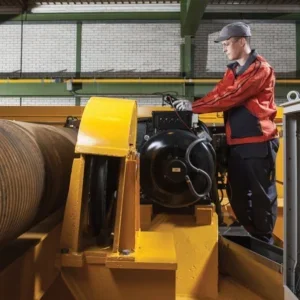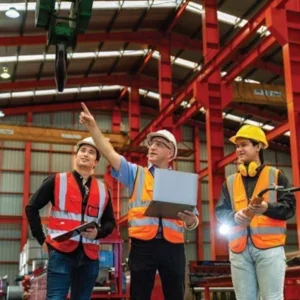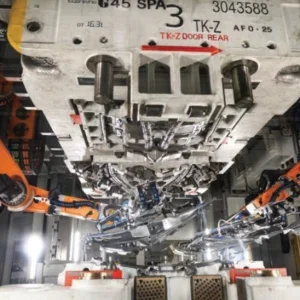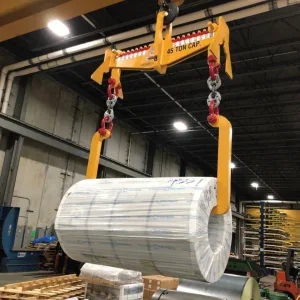The European Standards programme which supports the Machinery Directive has risen to many challenges in seeking to harmonise an often diverse range of national standards for lifting equipment. One of the most demanding has been EN 13155: 2003 Cranes – Safety – Non-fixed load lifting attachments, published in August by the British Standards Institute in the UK. It is demanding, firstly, because it covers a wide range of attachments, and secondly, because none of these attachments had been the subject of national or international standards before.
The Machinery Directive requires manufacturers to identify the hazards associated with their product and, in a hierarchical way, eliminate or reduce each risk to an acceptable level. At the highest level this means designing out the hazard where possible. At the lowest level it means relying on appropriate instructions for use. Moreover, when identifying the hazards, the manufacturer must take account of both normal use and foreseeable misuse of the equipment. Any product specification, such as a standard, should therefore do the same.
Harmonised European Standards have a quasi-legal status in that products made to the standards are deemed to meet those essential health and safety requirements of the Machinery Directive which they address. As such they have to be watertight and it should not be possible to make an unsafe product within the requirements of the standard. Complying with such a standard is therefore a reliable way for manufacturers to meet their legal duties under the Directive.
The rules for drafting harmonized European Standards demand that all requirements are verifiable by a repeatable method, either by reference to another standard or by a method specified within the standard. The rules also demand that the requirements are expressed in a style that avoids being prescriptive, thereby allowing for innovation. This effectively means that the product must be specified by performance rather than by a particular shape, dimensions or materials, for example.
EN 13155 was particularly ambitious in attempting to cover in a single standard almost everything that can hang on the hook of a crane except for general purpose slings. The UK view was always that the scope should be broken down into more manageable parts. But this was not supported by other countries, and although the scope was reduced a little following the enquiry stage, it still includes clamps of all kinds, lifting beams, crane forks, C hooks, and all types of vacuum lifters and lifting magnets. These products can be stand alone items, or combined – such as a lifting beam with several vacuum lifters attached to handle large sheet material. Furthermore they may be intended for applications where the load is manipulated as well as lifted – for example a clamp to lift and rotate a prefabricated concrete building panel during installation.
The scope excludes lifting attachments specifically intended to lift over people but the standard nevertheless recognises that the higher a load is lifted, the larger is the potential danger area beneath it in the event of a load being released and falling, particularly if the shape of the load makes it prone to gliding. This is especially relevant for those designs of vacuum lifters and magnets which rely on a continuous power supply and where back-up systems can only function for a limited time. It is entirely foreseeable that during the life of the equipment, the power supply can fail with a load in the air. The back-up system must therefore provide adequate time for anyone in the danger zone to escape.
Given its ambitious nature, how successful is the new standard? Initially it follows the usual CEN format, encompassing scope, normative references, terms and definitions and a list of significant hazards. At this point the scope is broken down into seven tables, each dealing with one of the principle types of equipment. This enables the reader to focus on those parts that are relevant to the equipment in question.
There are relatively few general safety requirements, but it is helpful to manufacturer and user alike that they have been established and apply uniformly to all types of equipment. For example, it is entirely foreseeable that a load will not always hang perfectly level or at the particular angle intended. Any deviation will clearly affect the stresses on the equipment so some tolerance must be allowed. The question is how much? For many years the rating of general purpose multi-leg slings has allowed for a tilt of 6º, a small but easily visible deviation equal to one minute of an analogue clock. It made sense to apply the same tolerance to equipment covered by this standard, much of which may incorporate standard sling elements.
Wherever possible, the requirements specific to each type of equipment are expressed in terms of a performance objective and generally reflect the current technology for each type. The design features required to eliminate hazards are often very simple. For example, a heavy crane hook can be prevented from unintentionally releasing a plate clamp by incorporating a short length of chain into the clamp suspension. In other cases the features required are exactly the same as for other types of machinery, such as socalled ‘hold to run’ controls for powered orientation of the load, in which continued motion requires the operator to keep a finger on the button.
To avoid expensive features being included when the risk does not warrant them, the requirements also reflect the intended applications. For example, vacuum lifters and magnets depending on a continuous electricity supply are often used to move relatively light loads close to the ground instead of repetitive manual handling. As the operator can stay in a safe position and the risk from power failure is low, the back-up system is not required.
This leads to another feature of the standard – the section that specifies the information for use to be provided by the manufacturer. As well as describing how the equipment operates, the manufacturer is required to state any limitations on the use of the equipment. This includes any foreseeable misuse to be avoided and also any operational
limits, such as the temperature range within which it will operate safely or the maximum ambient noise level at which any warning devices are effective. Some equipment may be restricted to indoor use or to height limits, and in some cases performance checks must be specified.
Some of the most important information for use is also required to be marked on the equipment and the standard specifies this for each type of equipment. Apart from the obvious, markings are required for information such as the self-weight where it is significant (such as for lifting beams), the range of material thickness for plate clamps, the minimum load for self actuated vacuum lifters and the position of the load’s centre of gravity on crane forks.
As far as verification is concerned, with little or no history of standards for these products, manufacturers had adopted a wide range of solutions. These not only varied between manufacturers but also according to the production quantity. Because the standard covers everything from one-off, purpose-designed devices to off-theshelf series produced equipment, it often permits more than one method of verifying a particular requirement. For example, the ultimate strength of a series produced item might be verified by sample destruction tests, whereas for a one off item it could rely on calculations. The verification methods also reflect the likelihood of variation. A feature incorporated into the design will always be present and need only be verified once for items made to that design. For something that might vary, such as the setting of a safety device, it needs to be verified on every item produced.
From a cold start, this first edition of EN 13155 is an important step forward. It contains much useful information to guide manufacturers who try to apply it responsibly. Inevitably there are some reservations, particularly about the methods of verification, and no doubt experience in applying the standard will reveal matters that need to be reconsidered in the next edition.






